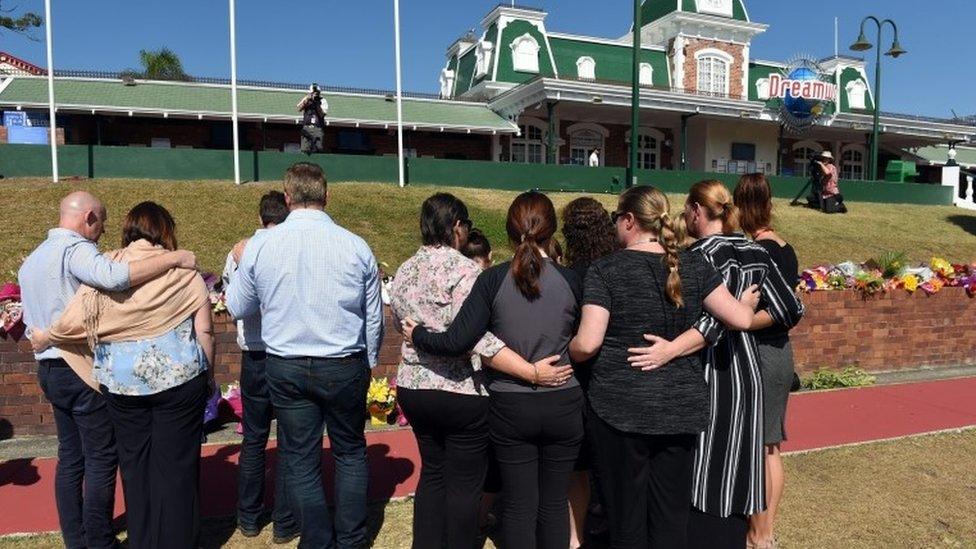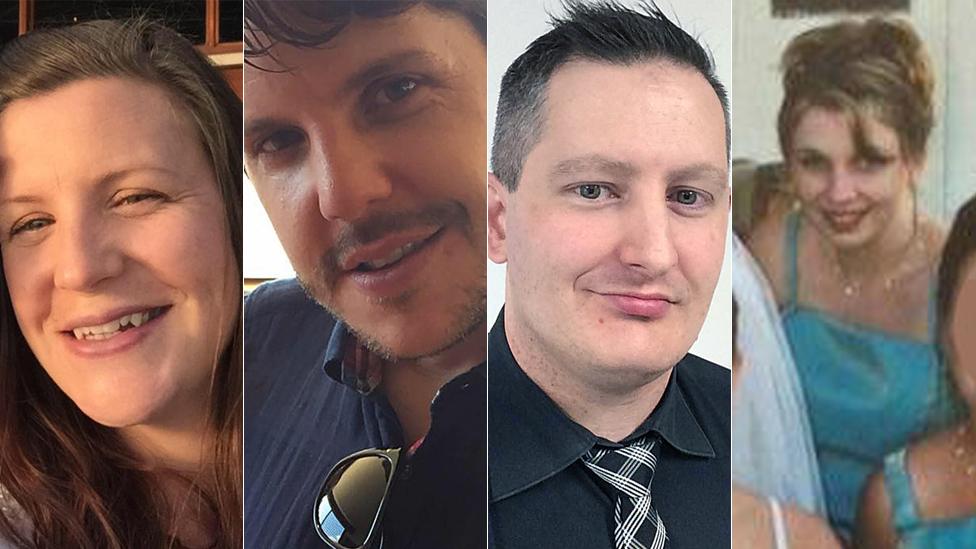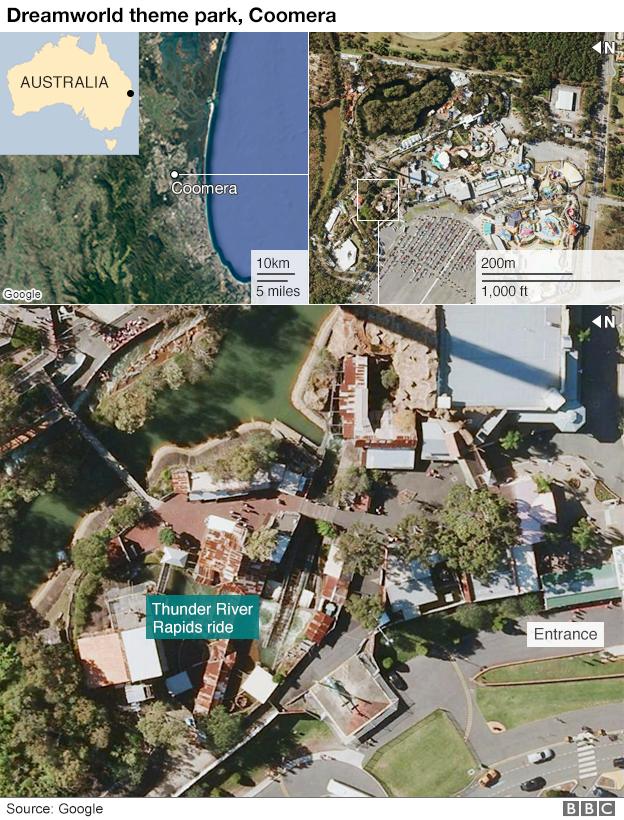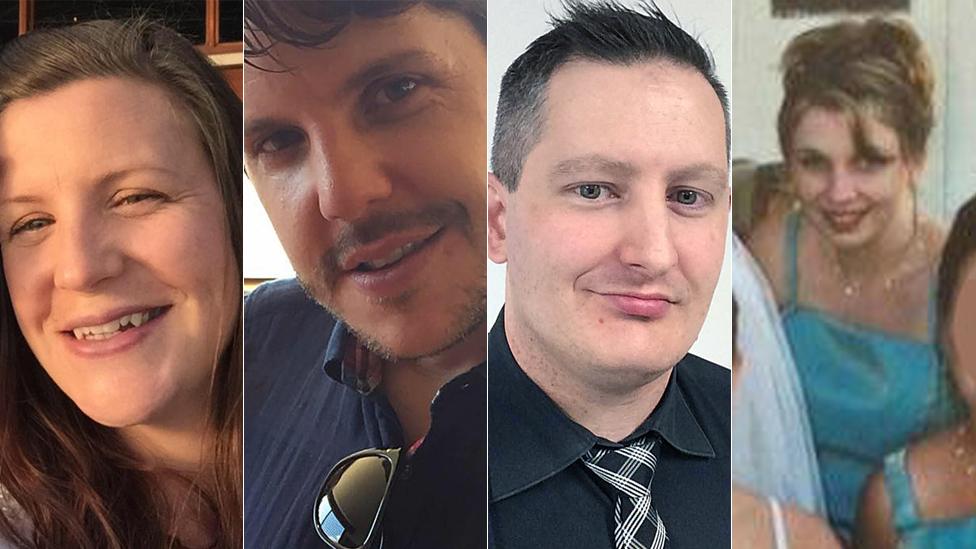Dreamworld: Australia theme park under fire from victims' families
- Published

People have been arriving at the park to pay tribute since Tuesday's accident
The owners of Australia's Dreamworld have been criticised for not directly contacting the families of the four people killed on one of its rides.
The family of two of the victims was said to be "furious" after the theme park's parent company claimed it had offered assistance.
Ardent Leisure's CEO, Deborah Thomas, has promised to donate her bonus to the victims' families via the Red Cross.
Plans to reopen the park on Friday for a memorial will now not go ahead.
Dreamworld said in a statement that police had advised they needed more time to complete their investigation.

(L-R) Kate Goodchild and Luke Dorsett were siblings, while Roozbeh Araghi was Mr Dorsett's partner. Cindy Low was not known to the three.
The victims have been named as Kate Goodchild, 32, her brother Luke Dorsett, 35, Mr Dorsett's partner, Roozbeh Araghi, 38, and Cindy Low, a 42-year-old New Zealand citizen who lived in Sydney.
They died when their raft on the Thunder River Rapids ride collided with another and flipped over.
A 10-year-old boy and a 12-year-old girl, who media reports say were related to the victims, were also on the raft. They were thrown free and survived.
Dreamworld: Who were the victims?
Ardent Leisure were scrutinised in the media for proceeding with a scheduled annual general meeting in Sydney on Thursday morning where Ms Thomas was awarded her performance bonus for the past financial year.
At an emotionally charged news briefing afterwards, the chief executive said the company had "finally made contact with the Dorsett family" to offer assistance.

Ardent Leisure chief executive Deborah Thomas receives the contact details from a journalist for the family of two of the victims killed at Dreamworld
But Ten News reporter Melinda Nucifora told Ms Thomas that the Dorsett family was watching on TV and had texted to say they were "furious" at the suggestion.
"They say that they've had no direct contact whatsoever. No one's even reached out to them," Ms Nucifora said.
Ms Thomas clarified her comments to say the company had been in touch through police, but had not spoken directly to the family "because we didn't know how to contact them" and asked for their phone number.
The visibly emotional executive finished the news conference by addressing the family directly, to give her "sincere sympathies for what you must be going through".
"Our hearts and our thoughts and prayers are with you and your family at this difficult time. And I will be calling you to see what assistance we can offer you."
Ms Thomas announced late on Thursday she was donating 100% of her A$167,500 (£100,000; $125,000) annual bonus "directed to support people affected by this tragic event" through the Red Cross.

'Catastrophic event'
Ardent Leisure has defended its safety record and added that the Thunder River Rapids ride had recently passed its annual safety inspection.
However, legal commentators have already speculated that the firm's directors could face serious legal consequences.
"Cases like this generally aren't just freak accidents, it's generally a series of events or something has actually gone wrong to result in such a significant catastrophic event," Brisbane-based personal injury lawyer Alison Barrett told the Australian Broadcasting Corp.
"If Dreamworld is prosecuted, the highest penalty is up to A$3 million for a corporation. So Dreamworld itself, and then the directors themselves can also be held personally liable and face up to five years in jail and other hefty penalties."

Worst amusement park accidents
Eight teenagers were killed in a 1984 fire at the Six Flags Great Adventure amusement park in New Jersey, US. Arsonists are believed to have started the blaze
Six people died in a failed simulated rocket launch in Shenzhen, China, in 2010. One of the cars on the centrifuge ride became loose, lost power and the ride fell to the ground in flames with 44 people inside
Five children were killed when the Battersea Park Big Dipper malfunctioned in the UK in 1972. Rope hauling cars to the top of launch slope broke and a safety mechanism failed, causing cars to roll into the boarding area
Three died at the Galaxyland Amusement Park in Alberta, Canada, in 1986. The last car of a four-car train on the Mindbender triple loop ride came away from the track, throwing off passengers before crashing into a concrete pillar
One person died in a rollercoaster accident at Expoland in Osaka, Japan, in 2007; another was killed at the Darien Lake theme park in New York State, US, in 2011
Sixteen people - including two teenage girls who needed leg amputations - were injured at UK's Alton Towers park in 2015. Operators failed to notice a stationary car on the 14-loop Smiler ride and overrode the stop mechanism, sending the next car into it
- Published26 October 2016
